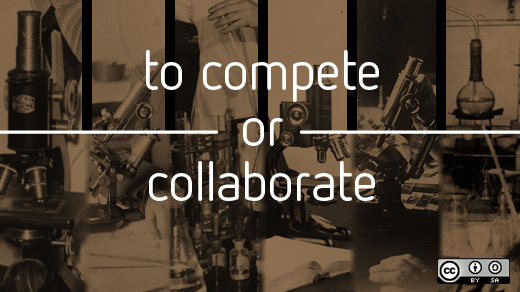In the first part of this series, I presented a list of factors that can influence someone's decision to approach a project or problem with either a cooperative or competitive mindset. In this follow-up article, I'll present a few scenarios that illustrate the ways these factors can interact to shape specific instances of collaboration or competition.
But first, let me recap. In that piece, I outlined a few factors that can influence someone's approach to openness. For example:
-
Problem simplicity (whether the issue was simple or complex)
-
Human relations (whether or not human relations were centrally important to the effort)
-
Knowledge of solution (whether you had expert knowledge of the issue or had little knowledge)
-
Process and duration (whether the issue would take a great deal of time or could be accomplished quickly)
-
Resources (whether the project required a great deal of resources or few resources), and
-
Importance and potential impact (whether the project was extremely important to both or one of the parties or not important to either).
To better explain how all these factors contribute to someone's attitude toward either cooperation or competition, I want to offer four scenarios for analysis. Hopefully these scenarios speak to similar situations in which you've found yourself.
Scenario 1
Imagine I've entered a store I've never visited before and found something rather rare, something I've spent a long time searching for. Here we have a situation that contains a single, focused project (get the item), one that revolves around something scarce (the item is difficulty to find), and one that has value primarily to me (the item has personal relevance). In this case, I would probably compete as much as possible to get that item. Being open and cooperative would require too much work and offer little benefit to me.
Scenario 2
Imagine I'm a truck salesman at a local dealer involved in truck sales, service, parts, leasing, and rentals. A national transportation company with a fleet of hundreds of trucks comes into the dealership to rent a truck for a few days (as one of its trucks is in our service department being repaired) and the firm can't use it for its deliveries. Knowing this single truck rental could lead to a wide range of other services and sales (like new truck sales, used truck sales, parts sales, service contracts, etc.), I will more than likely do everything I can to surprise this customer with added service while solving this single delivery problem (for example, I could offer to train the driver on how to get better fuel economy and maintain the vehicle's value, provide training to their vehicle maintenance staff to improve and expand their repair skills, establish a parts delivery program for them, or even introduce this transportation company to potential future customers).
In this scenario, we have a project that could lead to multiple future projects (so future projects are possible), one that will make me dependent on many people with whom I'll be working (greater importance on human relations), and one in which I will have to share a wide range of resources (which are rather abundant). So in this case, being more open and cooperative would be more important. What I want to do is convince this new client that working with our firm can be extremely valuable long-term. I want to build a lasting relationship. To be successful though, I will need the support and cooperation of many people in the dealership and must depend on them for certain tasks.
Scenario 3
Imagine I work for a very profitable Japanese computer component manufacturer in Japan and have a great customer prospect in the United States. The Japanese company needs this customer badly, as this business could, in turn, help the company build a reputation that may lead to business globally (doubly important because—in this scenario, anyway—the Japanese market is in a period of decline). The U.S. customer loves the product, but demands that there is a local service company to handle all service, replacement parts, training, and other support to make sure all after-sales issues get addressed quickly. The Japanese company thinks establishing a U.S. company would be too risky and costly just to supply only this one new customer. So it has to find a local U.S.-based partner it can authorize to handle all after-sales concerns. This might take as much as a year to set up; it requires a close, peer-to-peer, long-term collaboration with both the customer and the service supplier. Here we have a scenario in which my company needs a lot of help with a project that absolutely must succeed. Solving the problem requires multiple stakeholders performing different types of tasks. Plenty of resources are available to us, as we develop a solution. So being open and cooperative would be vital for success. More than likely, the work will have to start with very small, simple tasks that lead to more complicated issues (so all the parties get to learn how the other companies work). It would be best if the hierarchies of all three companies were very flat and the front-line people had the authority to make decisions and give suggestions. All this cooperative work could lead to decades of expanded business, so it is worth the effort—at least, it has been for me when I've worked on similar projects in both the U.S. and Europe.
Scenario 4
Now imagine this: You have a project that is so important that you have to cooperate and can't just walk away. But the other party is using manipulative, deceptive, and closed tactics to influence the outcome of the project. The party is avoiding disclosing details, ignoring probing questions, giving vague responses to your inquiries, and offering few suggestions. What should you do? When a project needs a great deal of cooperation to be successful, but one of the parties is not willing to be open and cooperative, I recommend—at least, initially—mimicking that style. Then, slowly and together, try to move gradually toward open cooperation and collaboration. The "closed" party likely believes that using those tactics will be the most beneficial, but that party must be convinced that a more cooperative approach would actually be more powerful. Once someone sees you working openly and doing it well, that party will see the weakness in the closed style. Once you see your partners moving to greater openness and cooperation, you can do the same. Note that this could occur in just a few meetings or take years to evolve.
Conclusion
I've covered many factors that can influence someone's approach to competition or collaboration. What I recommend you do for any project is to construct for yourself a diagram with "Competitiveness" on one side and "Cooperativeness" on the other. Then take the factors I've mentioned over these two articles and determine the "weight" of each one in your situation. To help you decide, you might take a look at my visual presentation on projects you should address using an open structure. Hopefully, then, you'll be able to visualize the best level of openness for the project at hand.






Comments are closed.